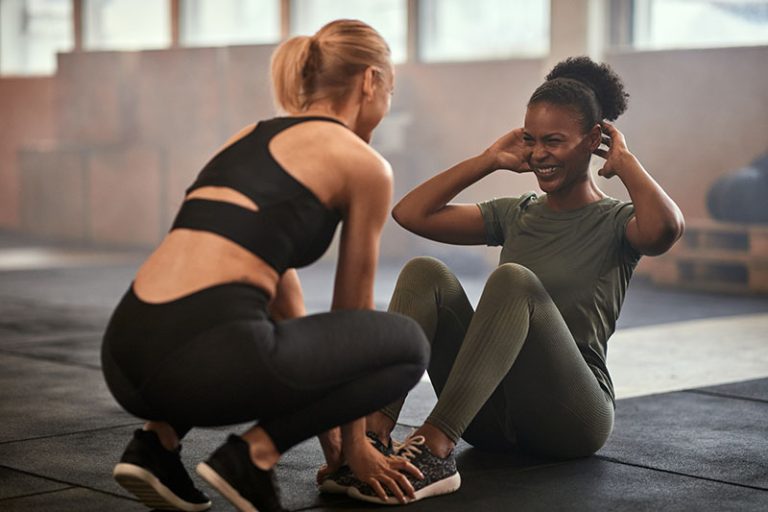Fitness isn’t just my business. It’s also my passion. But I’m just like you and there are times when I struggle with motivation.
There are mornings when it’s dark outside and I’d rather stay in bed than get to the gym at 6:00 am. There are nights when a burger and fries sound way better than grilled chicken and rice for dinner.
This is when having a workout partner can be invaluable. The best ones push you when you’re feeling tired in the gym, shoot you text messages of encouragement when needed, and celebrate your successes. I’m lucky to have developed an incredible group of workout partners over the years. Many of them have become close friends that not only get me through tough workouts but tough moments in life.
But a workout partner doesn’t need to be a best friend. Just having one that’s reliable gives you better odds of sticking with a program. You’ll still connect with them in ways that are more meaningful than meeting up for coffee.
Types Of Workout Partners
The most successful partnerships I’ve seen while competing and coaching fall into three main categories.
The Buddy System:
This is a friend or co-worker you either train with or meet for exercise at set times each week. Some duos will also hire a trainer for semi-private sessions to maximize their time.
This is a great approach for people with similar goals or friends who want to spend more time together. It’s also a nice balance for those who are too introverted for group exercise classes, but still need the accountability they can’t get working out solo.
But in the same way that great friends can make terrible roommates, they can also make lousy workout partners. If your partner isn’t motivated or complains all the time, it’ll start to bring you down as well. You also want someone who has relatively similar fitness goals as you.
The Group Effort:
This is a small group of people (3-6) whose schedules align to meet at the gym. It’s the perfect number of people to build a sense of community without feeling overwhelmed.
It also makes personal training sessions more affordable if the cost is split. A good trainer can quickly adapt a routine so that it meet’s everyone’s needs, even if some people are in better shape than others. I like to set up circuits with kettlebells and free weights or use side-by-side cardio machines. Everyone also pairs off for two-person exercises using medicine balls and resistance bands. There’s no shortage of exercises that a group can do!
The only downside is that coordinating multiple schedules can be difficult and endless group texts aren’t everyone’s thing. But the benefit of a small group is that one person not making it doesn’t force the session to be called off.
The Couple:
It makes sense to have a spouse or partner as your fitness companion. They have your back and want to see you at your best. A 2015 study in JAMA Internal Medicine found that if one person in a relationship made a healthy lifestyle change, their partner was more likely to do the same. It’s another way for you to bond and work towards something as a team.
“If I wanted to skip my daily walk, my excuse had to satisfy only me – and I was easy,” said Shelagh Hudson, who has made daily walks with her husband, Stephen, part of her lifestyle. “Not only does he encourage me to go faster and farther than I might have, but he doesn’t make any excuses. I’m a lot fitter now than when I was walking alone!”
However, there are some couples who should not (REPEAT. NOT.) workout together. It’s saved my relationship!
If you’re prone to bickering or being competitive with one another, it’s a surefire way for one of you to end up on the couch. Before you start working out with a significant other, talk about your fitness goals and map out how you’ll handle any potential conflicts in the gym.
Benefits Of Workout Partners
Accountability:
You’re more likely to show up when someone is expecting you there. It’s one thing to hit the snooze button if it’s only you. But do you really want to text some lame excuse after your partner already gotten to the gym? My workout buddies have learned not to try this with me!
Built-In Spotter:
A huge benefit of group training is having someone to spot you. If your back is hunched during a deadlift or you’re not doing a push-up correctly, it’s much easier for someone else to notice than for you to see it in a mirror. Improper form can lead to injuries and keep you out of the gym for weeks or even months.
Getting Out of Your Head:
We all have self-doubt creep in when we feel like another mile or 10 more reps isn’t physically possible. Having someone next to you doing the same exercise can refocus your mind to more positive thoughts. Research published in the International Journal of Stress Management showed that people who exercised on a stationary bike with a friend for 30 minutes felt calmer afterward than those who did it alone.
More Fun:
All of this will keep you coming back for more. Several of my clients who had to be dragged to the gym at first are now exercise friends.
If you like your friends and (mostly) like exercising, combining the two just doubles your fun. If exercising is still a chore for you, doing it with a friend will make it less of one. A 2013 study from the University of California echos this.
Research from the University of Aberdeen found that people who had a workout partner exercised more than those who went at it alone. The camaraderie that comes with sweating it out together can be invaluable.
“Our results showed that the emotional social support from the new sports companion was the most effective,” said lead study author Dr. Pamela Rackow. “It’s more important to encourage each other than doing the actual activity together.”
What Personality Are You?
Just like in dating, knowing yourself gives you the best chance of connecting with the right person. Although opposites can attract, workout partners are usually most successful if they have similar personality types.
I’m not everyone’s favorite person in the gym. I’m intense, don’t socialize, and curse like a sailor when lifting heavy weights. But I’ve accepted that about myself and found workout partners who appreciate that. Trust me, there’s someone for everyone!
The Planner:
Planners are more reserved in their approach to fitness, but being reserved doesn’t mean being less motivated. They just prefer familiar things and will lean towards activities they’re comfortable with. They’ll also likely spend a lot of time researching workouts and diet plans so they’re ready to go as soon as they arrive.
The Go-Getter:
Planners are more reserved in their approach to fitness, but being reserved doesn’t mean being less motivated. They just prefer familiar things and will lean towards activities they’re comfortable with. They’ll also likely spend a lot of time researching workouts and diet plans so they’re ready to go as soon as they arrive.
The Social Butterfly:
This person is more interested in having fun while exercising than getting a six-pack. They’re still dedicated when they show up, but it’s the relationships they build that keep them coming back to the gym. There’s nothing wrong with this social butterfly approach, but make sure your workout partner isn’t spending more time talking than running. You don’t want to slow down your progress.
The Ideal Workout Partner
Your personality might be the same as your workout partner, but a few other things should also sync up to get the most out of your sweat sessions.
Level Up:
If it’s possible, find a friend to work out with who’s in slightly better shape than you. We’re all inspired by watching people perform at a higher level. It motivates us to keep up and gives us a visual to work towards. (And who wants to have someone literally keep running circles around them?)
A 2012 trial published in the Annals of Behavioral Medicine had participants ride an exercise bike while their “virtual partner” gave them encouragement through a headset. That led to the participant’s performance level increased by 90% because they thought their partner was slightly fitter.
The bombshell? At the end of the study, it was revealed that there was no virtual partner! They had just been listening to a recording designed to spark feelings of teamwork.
Other studies have backed up these findings. One out of Kansas State University showed that people who exercised with a fitter partner worked out up to 200 percent longer and harder than others.
The trick is finding the right balance. Some people may not mind if their workout partner is in significantly better shape, but others will get intimidated and shut down. If you find yourself avoiding workouts or overeating due to stress, it’s a good sign that your workout partner isn’t right for you.
Similar Lifestyles:
Your fitness goals may not be the same, but your commitment to good health should be. Think about eating out with friends. You probably won’t get a cheeseburger if they all order a salad, and vice-versa. Our habits are contagious, both good and bad, so make sure you’re on the same page when it comes to things like post-workout meals.
Similar(-ish) Goals:
You don’t need to have the same fitness goals down to the letter, but they should be in the same ballpark. If you want to lose weight and your friend wants to build muscle, it may not be a match unless you only plan on walking in together.
Same Schedule:
It’s easy to make fitness a habit if you carve out time for it. Find a few times each week that you and your partner are confident that you can commit to.
How to Find a Workout Partner
Ask me! If you’ve been to TTP Fitness, then I know your level of experience in the gym and have a good sense of your personality. Our team can help connect you to people with similar goals, fitness levels, and personalities so that you get the most from a duo or group experience.
Co-workers:
Do you have a co-worker who seems like they’re interested in healthy living? Talk to them about it! You both probably have similar office schedules and that makes it easy to plan exercise time together. Even if they’re not a match for a workout partner, they might know someone who is.
Reach out to friends:
You already know which friends live in the gym or make exercise part of their daily life. Ask to set up a regular time to meet at the gym or offer to take an exercise class together. This could also be a great way to reconnect with old friends you’ve lost touch with.
Join a Meetup Group:
If you’re shy about asking people to join you for exercise, Meetup groups take away the awkwardness. They have everything from hiking groups to outdoor yoga classes throughout the Portland area. There are even exercise classes over Zoom so you don’t have an excuse to skip your workout on a rainy day!
Apps:
I prefer the more old-school way of meeting people, but plenty of friends swear by apps that are Tinder for the gym. Gymder, FitCliq and Bvddy are a few of the apps where you swipe left or swipe right on potential gym partners. Just be clear in what you’re looking for on your profile. Saying you’re “down for whatever” might make it sound like you’re, well, down for whatever.
Online Communities:
Motivation can be tough during COVID times, especially if you’re cautious about being around people. Online social networks are a perfect way to connect with other like-minded people. MyFitnessPal, Fitbit and Jefit apps let you track each other’s progress and encourage one another.







